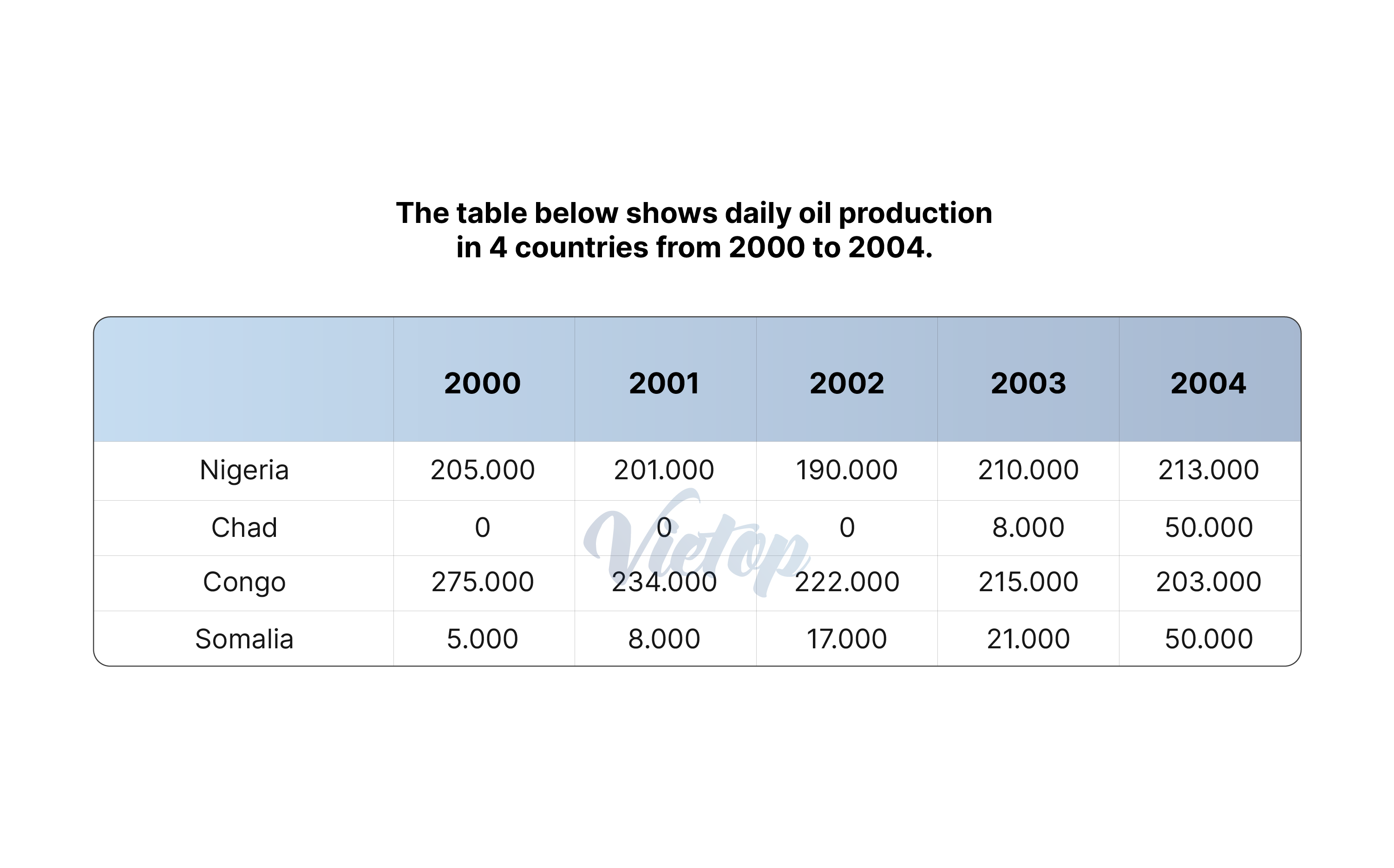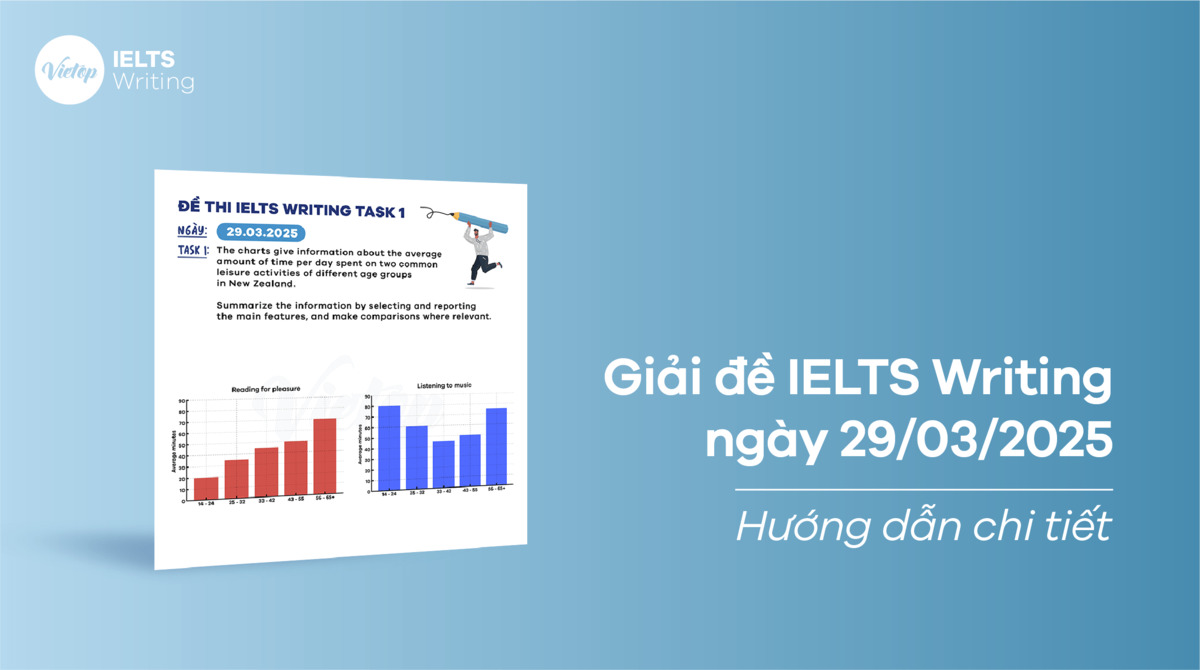Vietop gửi bạn bài giải đề IELTS Writing ngày 24/06/2023 bên dưới nhé! Các bạn theo dõi và ôn luyện IELTS Writing thật tốt nhé!
IELTS Writing task 1
Task 1: The table shows the amount of oil produced everyday in Nigeria Chad, Congo and Somalia during a 5-year-period, from 2000 to 2004.

Sample
The table compares the number of oil barrels produced daily in 4 African countries between 2000 and 2005.
A glance at the graph provided indicates that each country experienced different production trend in this period, resulting in the volatility of the region’s overall output. Chad, however, stood out the most as the country with biggest growth rate in oil production despite being the smallest producer most of the time.
Looking first at the two major producers, in 2000, Congo’s production was at 275 thousand barrels per day (tb/d), which was nearly half as much as that of Nigeria, at just 205 tb/d. In the next 4 years, Congo’s production output slipped by more than a quarter to just 203 tb/d while that of Nigeria was broadly unchanged amid some fluctuations, dethroning Congo as the largest producer in the process.
Turning to less significant producers, Somalia’s output in 2000 was negligible at merely 5 tb/d. Nevertheless, production rose 10 fold in the next 4 years, establishing the country as a sizable oil producer in the region. Chad, on the other hand, had had no oil production until 2003 when their initial capacity stood at 8 tb/d. In 2004, this figure would become a robust 50 tb/d however.
Bạn đang gặp khó khăn với dạng table trong IELTS Writing Task 1? Bạn muốn tìm một phương pháp học tập hiệu quả để chinh phục dạng bài này? Với khoá luyện thi IELTS tại Vietop sẽ giúp bạn làm chủ mọi dạng bài từ cách phân tích đề, xác định yếu tố trọng tâm đến cách lập dàn ý và triển khai bài viết logic, giúp bạn tự tin chinh phục kỹ năng viết và các kỹ năng nghe, nói, đọc trong kỳ thi IELTS.
Vocabulary
- Barrel (n): thùng
- Glance (n): cái nhìn
- Indicate (n): cho thấy
- Growth rate (n): tốc độ tăng trưởng
- Major producer (n): nhà sản xuất lớn
- Slip (v): trượt dốc
- A quarter (n): một phần tư
- Broadly unchanged (adj): nhìn chung không đổi
- Amid (prep): trong bối cảnh
- Dethrone (v): tước ngôi
- Output (n): sản lượng
- Negligible (adj): không đáng kể
- Merely (adv): chỉ
- Sizable (adj): đáng kể
- Capacity (n): công suất
- Robust (adj): lớn đáng kể
Phân tích
Overview:
Có sự khác biệt khá lớn giữa xu hướng của các nước (một số tăng, nước khác lại giảm, có nước lại dao động) vì vậy có thể lấy tổng sản lượng ra để nói rằng sản lượng tổng của khu vực có sự biến động trong giai đoạn được cho. Ngoài ra, Chad cũng là quốc gia dù sản lượng nhỏ nhất (hầu hết trong giai đoạn) nhưng tốc độ tăng trưởng về sản lượng lại lớn nhất.
- Body 1: So sánh xu hướng 2 nhà sản xuất lớn nhất
- Body 2: So sánh xu hướng 2 nhà sản xuất nhỏ hơn
Xem thêm:
Giải đề IELTS Writing ngày 10/6/2023
IELTS Writing task 2
Task 2: Nowadays, more and more people decide to have children later in their life. What are the reasons for this? Do the advantages of this outweigh disadvantages?
Sample
In today’s world, it has been observed that people across all social milieu do not have childbearing intentions until much later in their life. This phenomenon stems from several factors and in my opinion, is generally a negative development.
Several factors can be attributed to the decision to delay childbearing but the biggest one has always been financial concerns. Child-rearing is a costly process involving astronimical expenditures from food, education, child care to clothing and many other miscellaneous expenses. Such spending does not stop when the child reaches maturity but usually continues well until he or she graduates from higher education institutions.
This explains why couples nowadays tend to wait until one or both of them have become well-established in their career since it gives them a sense of financial stability. Loss of freedom, though not as significant, is also another underlying factor. People now have burning desires for novelty. Many aspire to travel the world, meet new people and broaden their horizon, all of which are not achievable should they become parents and thus, many simply decide to postpone the task for the later stage in their life.
Admittedly, having children latter enables parents to be better prepared both in terms of knowledge and finance. Raising a baby is not a simple task since parents needs to be equipped with lots of knowledge such as baby sitting, nutrition, psychology and so on so that they can successfully raise their kids. A strong financial foundation is also required to bring up a well-rounded child. These factors are more strongly present in older parents.
Having said that, mothers having children late in life are often blamed for miscarriages, birth defects from chromosomal issues and the child’s poor overall heath due to their significantly lower fertility rate, hence their poor chance of conceiving a healthy baby. Such problem far exceeds any benefits that having a child late in life can bring about since it can result in a lifetime of suffering for the child, disregarding all the aforementioned advantages.
In conclusion, although the reasons behind couples having children later in their life are best explained by their financial worries and desire for freedom, the disadvantages of this trend still overshadow its advantages.
Vocabulary
- Social milieu (n): tầng lớp xã hội
- Childbearing intention (n): mong muốn có con
- Child-rearing (n): việc nuôi lớn con cái
- Astronimical (adj): to khủng khiếp
- Maturity (n): trưởng thành
- Well-established (n): vững chắc
- Novelty (n): sự mới lạ
- Aspire (v): khao khát
- Well-rounded (n): toàn diện
- Miscarriage (n): ca sảy thai
- Birth defect (n): dị tật bẩm sinh
- Chromosomal issue (n): vấn đề về nhiễm sắc thể
- Conceive (v): thụ thai
- Exceed (v): vượt qua
- Suffering (n): sự thống khổ
- Disregard (v): làm cho mất đi tính quan trọng
Phân tích
Quan điểm: Có nhiều nguyên nhân dẫn đến việc ngày nay người ta chọn có con trễ hơn so với ngày xưa và điều này là một xu hướng tiêu cực.
Body 1: Nguyên nhân chính cho xu hướng này là những quan ngại về mặt tài chính. Việc sợ mất đi sự tự do cũng là yếu tố góp phần cho sự phổ biến của xu hướng này.
Body 2: Đúng là việc có con trễ hơn có những lợi ích nhất định. Cụ thể, nó cho bố mẹ thời gian để trang bị kiến thức và chuẩn bị tài chính
Body 3: Dù vậy, việc có con trễ có thể gây ra các vấn đề về như sẩy thai, dị tật, và sức khỏe kém cho đứa trẻ. Những điểm xấu này là quá lớn và khiến cho những điểm tốt nêu ra trước đó không còn có trọng lượng nữa.
Xem ngay: Tổng hợp đề thi IELTS Writing 2023 kèm bài mẫu chi tiết
Hy vọng bài giải đề IELTS Writing ngày 24/06/2023 đã cung cấp thêm cho bạn nhiều từ vựng, cấu trúc và ý tưởng để vận dụng cho bài viết của mình khi luyện thi IELTS. Chúc bạn thi IELTS tốt!
Ngoài ra, các bạn cần phải thường xuyên cập nhập lịch thi IELTS để có kế hoạch ôn thi IELTS phù hợp nhé!


![[ACE THE TEST] Giải đề IELTS Writing ngày 07/04/2025](https://vietop.edu.vn/wp-content/uploads/2025/04/giai-de-ielts-writing-ngay-07-04-2025.png)

![[ACE THE TEST] Giải đề IELTS Writing ngày 15/03/2025](https://vietop.edu.vn/wp-content/uploads/2025/03/giai-de-ielts-writing-ngay-15-03-2025.jpg)
![[ACE THE TEST] Giải đề IELTS Writing ngày 22/03/2025](https://vietop.edu.vn/wp-content/uploads/2025/03/giai-de-ielts-writing-ngay-22-03-2025.jpg)
![[ACE THE TEST] Giải đề IELTS Writing ngày 08/03/2025](https://vietop.edu.vn/wp-content/uploads/2025/03/giai-de-ielts-writing-ngay-08-03-2025.jpg)
![[ACE THE TEST] Giải đề IELTS Writing ngày 06/03/2025](https://vietop.edu.vn/wp-content/uploads/2025/03/giai-de-ielts-writing-ngay-06-03-2025.jpg)
![[ACE THE TEST] Giải đề IELTS Writing ngày 22/02/2025](https://vietop.edu.vn/wp-content/uploads/2025/02/giai-de-ielts-writing-ngay-22-02-2025.jpg)
